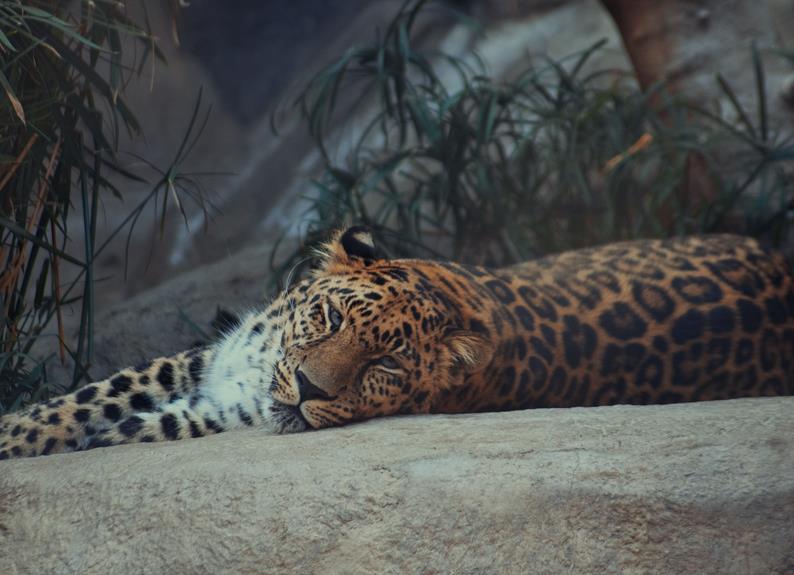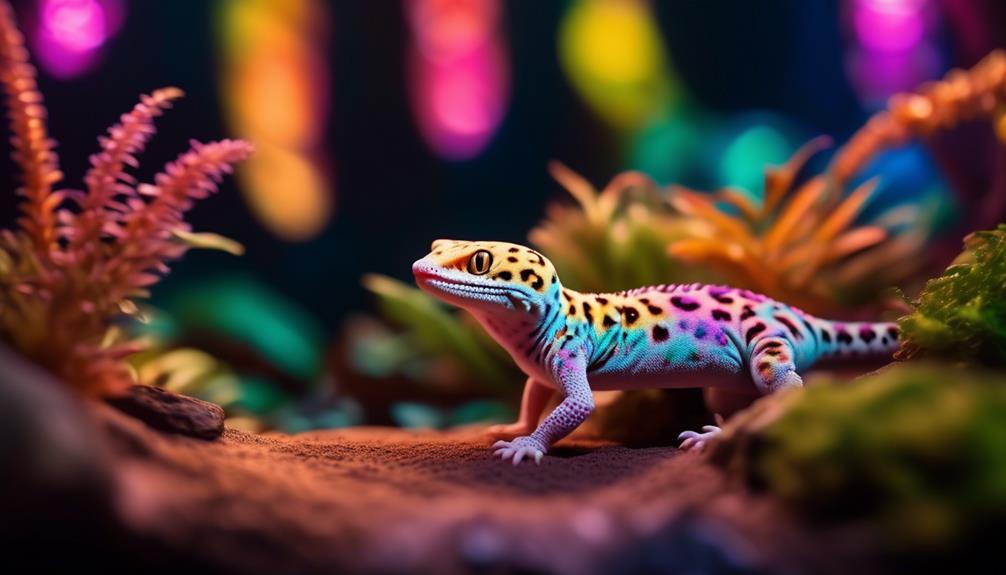Did you know that leopard geckos have a fascinating mating behavior? In fact, they have been observed to engage in intricate courtship rituals and employ various communication strategies during the mating process.
Understanding their reproductive strategies and patterns can provide valuable insights into their behavior.
Factors such as temperature and lighting also play a significant role in influencing their mating behavior.
In this article, we will explore the intriguing world of leopard gecko mating, shedding light on their complex behaviors and the role of their environment.
Key Takeaways
- Elaborate mating displays, including visual and tactile signals, are important for courtship in leopard geckos.
- Communication strategies, such as rhythmic swaying motion, tail waving, body vibration, and vocalizations, play a role in attracting and evaluating potential mates.
- Female mate selection is based on the intensity, duration, and frequency of courtship displays, as well as the fitness and readiness to mate conveyed through vocalizations.
- The environment, including temperature regulation, habitat quality, and the presence of suitable nesting sites, plays a significant role in leopard gecko mating behavior.
Courtship Rituals of Leopard Geckos
You'll be fascinated by the courtship rituals of leopard geckos. These reptiles engage in elaborate mating displays to attract potential mates and ensure successful reproduction. The process of mate selection is crucial for their survival and continuation of the species.
Male leopard geckos use various visual and tactile signals during courtship to demonstrate their fitness and suitability as a mate. They perform a rhythmic swaying motion while waving their tails and vibrating their bodies. This display not only catches the attention of females but also conveys their physical strength and genetic quality.
Female geckos evaluate these displays and choose their mates based on the intensity, duration, and frequency of the male's performance. Understanding these courtship rituals is essential for those interested in caring for leopard geckos and ensuring their successful breeding in captivity.
Communication Strategies During Mating
To attract a mate, leopard geckos employ a variety of communication strategies during mating, including vocalizations and pheromone signaling. Communication signals play a vital role in mate selection for these reptiles.
Male leopard geckos produce a series of vocalizations, known as 'chirps,' to attract females. These chirps are low-frequency sounds that are produced by vibrating their vocal cords. The frequency and duration of the chirps can convey information about the male's fitness and readiness to mate.
Additionally, leopard geckos use pheromones to communicate their reproductive status. They release chemical signals through their skin, which can be detected by potential mates. These pheromones provide information about the gecko's sex, age, and overall health, helping in the selection of suitable partners for successful mating.
Through these communication strategies, leopard geckos ensure successful reproduction and continuation of their species.
Reproductive Strategies and Patterns
While leopard geckos have various reproductive strategies and patterns, they primarily rely on courtship rituals and territorial displays to attract a mate. These behaviors are crucial during the mating seasonality, which typically occurs during the warmer months.
To better understand the reproductive strategies of leopard geckos, here are three important points to consider:
- Courtship Rituals: Male leopard geckos engage in elaborate courtship displays to attract females. These displays involve tail waving, head bobbing, and body movements that signal their readiness to mate.
- Territorial Displays: Male geckos establish and defend territories to attract mates. They mark their territories with scent markings and engage in aggressive behavior towards rival males.
- Mate Selection: Female leopard geckos have the ability to choose their mates. They assess the quality of potential mates based on their size, health, and courtship displays. Females are more likely to choose males with vibrant colors and strong courtship behaviors.
Understanding these reproductive strategies and patterns helps researchers and reptile enthusiasts better appreciate the complex mating behavior of leopard geckos.
Factors Influencing Mating Behavior
One important factor influencing mating behavior in leopard geckos is the availability of suitable nesting sites. These geckos require specific conditions for successful reproduction, and the availability of suitable nesting sites plays a crucial role. Leopard geckos lay their eggs in secure and warm locations, such as underground burrows or crevices.
The influence of genetics also plays a significant role in mating behavior. Certain genetic traits, such as color patterns or size, can attract potential mates.
Additionally, the impact of social hierarchy affects mating behavior in leopard geckos. Dominant males are more likely to successfully mate with females, as they've higher status within the social hierarchy.
Understanding these factors is essential in creating suitable environments for breeding leopard geckos and ensuring their successful reproduction.
The Role of Environment in Leopard Gecko Mating
Leopard geckos frequently rely on their environment to facilitate successful mating. The role of temperature and the impact of habitat are crucial factors that influence their mating behavior. Here are three key points to consider:
- Temperature: Leopard geckos are ectothermic, meaning their body temperature is regulated by the environment. Proper temperature is essential for the mating process. During the breeding season, maintaining a temperature gradient within their habitat allows them to regulate their body temperature and engage in courtship behaviors effectively.
- Habitat: The quality and suitability of their habitat play a significant role in leopard gecko mating. A well-designed enclosure with appropriate hiding spots, substrate, and a comfortable temperature range will create an ideal environment for successful courtship and mating. A conducive habitat also reduces stress levels and ensures the overall well-being of the geckos.
- Environmental cues: Leopard geckos rely on environmental cues to determine the readiness for mating. These cues include changes in temperature, light patterns, and even the presence of other geckos. The environment provides the necessary stimuli for courtship rituals, such as tail-waving, head bobbing, and vocalization.
Understanding the role of temperature and the impact of habitat on leopard gecko mating is vital for creating a suitable environment that promotes successful reproduction. By providing the right conditions, you can ensure the health and well-being of these fascinating reptiles.
Frequently Asked Questions
What Is the Average Lifespan of a Leopard Gecko?
The average lifespan of a leopard gecko is around 10 to 20 years. Understanding their reproductive cycle is essential as it can help you provide the necessary care and create a suitable breeding environment.
How Often Do Leopard Geckos Mate in a Year?
Leopard geckos typically mate during the breeding season, which occurs once a year. The mating frequency varies among individuals, but it is common for them to mate multiple times during this period.
What Is the Size Difference Between Male and Female Leopard Geckos?
Did you know the size difference between male and female leopard geckos is a classic example of sexual dimorphism? Males are typically smaller, measuring around 7-8 inches, while females can reach 8-10 inches in length.
Can Leopard Geckos Change Their Mating Preferences Over Time?
Leopard geckos can change their mating preferences over time due to environmental factors. This has evolutionary implications as it allows them to adapt to different conditions and maximize their reproductive success.
Are There Any Specific Signs or Behaviors That Indicate a Leopard Gecko Is Ready to Mate?
When a leopard gecko is ready to mate, it displays courtship rituals. These behaviors include tail wagging, head bobbing, and vibrating. Environmental factors like temperature and lighting also play a role in their mating behavior.
Conclusion
You have now delved into the intricate world of leopard gecko mating behavior. Through understanding their courtship rituals, communication strategies, and reproductive patterns, we see that these fascinating creatures have evolved unique strategies to ensure successful mating.
Factors such as environmental conditions play a crucial role in influencing their behavior. By exploring the scientific aspects of leopard gecko mating, we gain a deeper appreciation for the complexity and beauty of nature's intricate coincidences.



